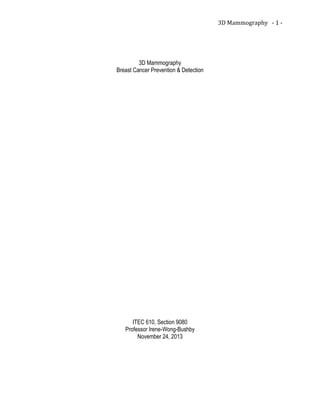3D mammography is a new technology that produces 3D images of breast tissue by combining multiple x-ray images taken from different angles. Clinical trials have found that 3D mammography increases cancer detection rates by 47% compared to standard 2D mammography. It also reduces unnecessary patient recalls by 28-40% by minimizing issues with dense breast tissue. The enhanced 3D images allow for more precise localization of abnormalities. 3D mammography has the potential to improve outcomes by finding more cancers early while also reducing patient anxiety and healthcare costs from unnecessary additional testing.

![3D Mammography - 2 -
Abstract
Breast cancer is the second leading cause of cancer death in women, exceeded only by lung cancer.
The (American Cancer Society [ACS], 2013) predictions are:
About 232,340 newly diagnosed cases of invasive breast cancer
About 64,640 newly diagnosed cases of carcinoma in situ (CIS), a non-invasive and earliest form
of breast cancer
About 39,620 women will die from breast cancer
These statistics make early detection screening vital. Mammography is an invaluable tool for
identifying breast cancer close to its onset. However, the tissue intersections portrayed on mammograms
may generate considerable hurdles in the process of detecting and diagnosing irregularities. Park, Franken,
Garg, Fajardo, and Niklason (2007) found initiating diagnostic testing because of a questionable result at
screening mammography frequently causes patients unnecessary anxiety and incurs increased medical
costs. 3D Mammography (aka Digital Breast Tomosynthesis (DBT)) is more successful at detecting and
preventing Breast Cancer than the established 2D method alone. Research has indicated an increase of
47% in cancer detection using 3D Mammography compared to 2D digital mammography alone (Smith,
2012). Additionally a 28% to 40% reduction in non-cancer patient recall rates has been observed (Smith,
2012).
This paper will compare the technology of 2D mammography versus 3D Mammography, and the
benefits of 3D Mammography in early breast cancer detection.
Introduction
Breast cancer is the most frequently detected cancer identified in women today. 2D
mammography is a specific form of mammography which uses digital receiving devices or receptors and
computers to capture images during the screening and diagnosis for breast cancer. The FDA approved the
use of 2D digital mammography in 2000. Since that time 2D mammography has become the established](https://image.slidesharecdn.com/abec83be-f2a8-4ca8-924e-c3bf697b1daf-150731190955-lva1-app6891/85/Research-Paper_Joy-A-Bowman-2-320.jpg)




